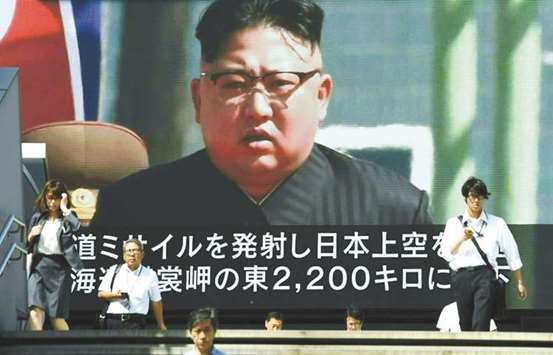North Korea fired a second missile over Japan far out into the Pacific Ocean yesterday, South Korean and Japanese officials said, deepening tension after Pyongyang’s recent test of its sixth and most powerful nuclear bomb.
The UN Security Council was to meet later in the day to discuss the launch at the request of the United States and Japan, diplomats said. The missile flew over Hokkaido in the north and landed in the Pacific about 2,000km to the east, Japanese Chief Cabinet Secretary Yoshihide Suga told reporters.
The missile reached an altitude of about 770km and flew for about 19 minutes over about 3,700km, according to South Korea’s military — far enough to reach the US Pacific territory of Guam, which the North has threatened before.
The ICBM
On August 29, North Korea launched an intermediate-range ballistic missile, the Hwasong-12, which travelled 2,700km over Japan.
“The range of this test was significant since North Korea demonstrated that it could reach Guam with this missile,” the Union of Concerned Scientists said in a statement. But it said the accuracy of the missile, still at an early stage of development, was low.
Warning announcements about the missile blared around 7am in parts of northern Japan, while many residents received alerts on their mobile phones or saw warnings on TV telling them to seek refuge. US Secretary of Defense Jim Mattis said the launch “put millions of Japanese into duck and cover”, although residents of northern Japan appeared calm and went about their business as normal after the second such launch in less than a month.
The US military said soon after the launch it had detected a single intermediate range ballistic missile but the missile did not pose a threat to North America or Guam, which lies 3,400 km from North Korea.
US officials repeated Washington’s “ironclad” commitments to the defence of its allies. Secretary of State Rex Tillerson called for “new measures” against North Korea and said the “continued provocations only deepen North Korea’s diplomatic and economic isolation”.
A poll by Gallup Analytics suggested a majority of Americans appeared ready to support military action against North Korea, at least as a last resort.
Some 58% said they would favour taking military action if economic and diplomatic efforts failed to achieve US goals. “This is significantly higher than the 47% in favour the last time Gallup asked this, in 2003,” the group said.
South Korean President Moon Jae-in said dialogue with the North was impossible at this point. He ordered officials to analyse and prepare for possible new North Korean threats, including electromagnetic pulse and biochemical attacks, a spokesman said. Russia said the missile test was part of a series of unacceptable provocations and that the UN Security Council was united in believing such launches should not be taking place.
The council was to meet, diplomats said, just days after its 15 members unanimously stepped up sanctions against North Korea over its September 3 nuclear test. Those sanctions imposed a ban on North Korea’s textile exports and capped its imports of crude oil.
North Korea has launched dozens of missiles under young leader Kim Jong-un as it accelerates a weapons programme designed to give it the ability to target the United States with a powerful, nuclear-tipped missile. Two tests in July were for long-range intercontinental ballistic missiles capable of reaching at least parts of the US mainland.
“This rocket has meaning in that North Korea is pushing towards technological completion of its missiles and that North Korea may be feeling some pressure that they need to show the international community something,” said Yang Uk, a senior research fellow at the Korea Defence and Security Forum.
Last month, North Korea fired an intermediate range missile from a similar area near the capital Pyongyang that also flew over Hokkaido into the ocean and said more would follow. “The first time was unexpected, but I think people are getting used to this as the new normal,” said Andrew Kaz, who teaches English in Kushiro City in Hokkaido. “The most it seemed to disrupt was my coffee.”
South Korea said it had fired a missile test into the sea to coincide with North Korea’s launch and the presidential Blue House has called an urgent National Security Council meeting. Japan also convened a National Security Council meeting.
Pyongyang had threatened a day earlier to sink Japan and reduce the United States to “ashes and darkness” for supporting the UN Security Council’s latest resolution and sanctions.
H-bomb
The US general overseeing America’s nuclear forces said on Thursday he assumed that North Korea’s latest nuclear test was in fact a hydrogen bomb, as Pyongyang had claimed, based on the size of the blast. The North accuses the United States, which has 28,500 troops in South Korea, of planning to invade and regularly threatens to destroy it and its Asian allies.
The US dollar fell sharply against the safe-haven yen and Swiss franc in early Asian hours in response to the launch, although losses were quickly pared in very jittery trade. US President Donald Trump had been briefed on the latest launch, the White House said.

Pedestrians walk in front of a large video screen in Tokyo broadcasting a news report showing North Korean leader Kim Jong-un following a North Korean missile test that passed over Japan yesterday.
